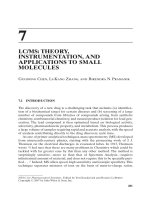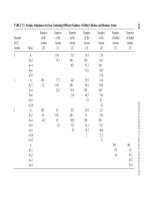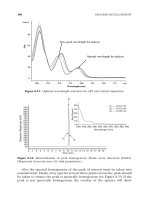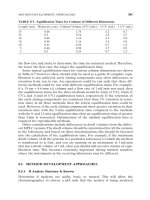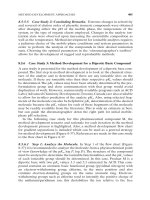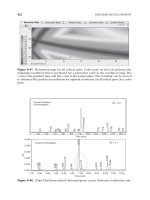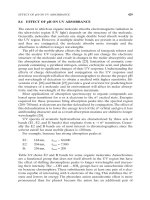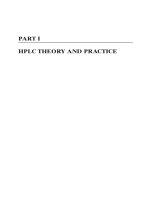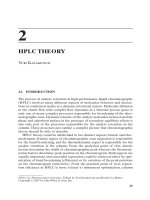Tài liệu HPLC for Pharmaceutical Scientists 2007 (Part 18) pdf
Bạn đang xem bản rút gọn của tài liệu. Xem và tải ngay bản đầy đủ của tài liệu tại đây (213.27 KB, 25 trang )
18
TEMPERA
TURE AS A VARIABLE IN
PHARMACEUTICAL APPLICATIONS
Roger M. Smith
18.1 THE INFLUENCE OF TEMPERATURE ON
CHROMATOGRAPHY
For much of the early development of liquid chromatography, separations
were carried out at ambient temperature and many laboratories did not
attempt to regulate or control the temperature of the column. Frequently, the
column would be mounted on the side of the pump or detector and thus would
be subjected to changes in the room temperature or changes due to external
factors, such as sunlight. However, the influence of temperature on the reten-
tion times of analytes was well known and had been studied by a number of
groups—in particular, Melander et al. [1]. They demonstrated that for most
analytes there was a linear relationship between the retention factor of an
analyte and the inverse of the absolute column temperature (see Chapter 1).
However, for a few samples there has been an increase in retention with
increasing temperature usually attributed to entropy effects. In the case of
polyethylene glycol oligomers, the optimum separation was achieved with a
negative temperature gradient [2]. The retention of leucine-phenylalanine
at low pH and high % acetonitrile also increased with increasing tempera-
ture [3].
As a result, temperature can play an important role in pharmaceutical
analysis. The precise and accurate control of temperature can improve repro-
ducibility and method transferability (Section 18.2). In recent years, the use of
811
HPLC for Pharmaceutical Scientists, Edited by Yuri Kazakevich and Rosario LoBrutto
Copyright © 2007 by John Wiley & Sons, Inc.
elevated or unconventional temperatures have been examined as methods to
alter selectivity and column efficienc
y, either with conventional mobile phases
(Section 18.3) or with solvent free systems, such as superheated water (Section
18.4). Although normally the interest has been in elevated temperatures, sub-
ambient chromatography has provided a number of interesting separations
(Section 18.5).
18.2 EFFECTS ON METHOD TRANSFERABILITY
AND REPRODUCIBILITY
As pharmaceutical analysis developed and the need for long-term repro-
ducibility became more important, instrument manufacturers recognized the
need for temperature stability and by the early 1990s started to include column
ovens as an integral part of their instruments. In most cases the temperatures
were controlled near or just above ambient because the aim was to ensure a
reproducible result rather than to employ temperature as a method variable.
However, even now, many chromatographers carry out separations at ambient
temperature, partly on the assumption that the conditions in a heated or air-
conditioned building are constant. The reality is often different and the tem-
perature around a column can alter quite markedly. Sunlight can shine on a
column, draughts can blow on the column, or the air-conditioning can be pro-
grammed to lower the laboratory temperature overnight or at weekends as a
cost-saving exercise.The result is that the retention of analyte compounds can
move outside predefined retention windows and the system can show daily or
long-term variations and poor reproducibility.
Of particular concern is that methods that have been developed and tested
in one laboratory are often transferred to another laboratory in the same or
a different company as the drug product moves from discovery through toxi-
cology, stability studies, formulation, scale-up, and eventually to manufactur-
ing quality control. Frequently, it is found that at each transfer, a new method
optimization and a revalidation are required, each taking time and money.Sur-
prisingly, relatively little research had addressed this problem. There are only
few reports of interlaboratory collaborative studies where the target has been
to assess the transferability of retention or resolution. In contrast, the trans-
fer of quantitation has been repeatedly examined, but this is based on relative
peaks areas to an internal or external standard measured under the same con-
ditions. This usually compensates for differences in retention time. Typically,
interlaboratory studies produce retention time reproducibility, which is much
worse than intralaboratory measurements. A comparison of the analysis of
forensic drugs in different UK labs [4] and in an international study [5] showed
wide variation in relative and absolute retention times even through the
mobile phases were closely specified and all the columns were from a single
batch of packing material.
Within a single laboratory, the situation could be improved markedly by
employing temperature control of the column, with an oven or water bath [6].
812 TEMPERATURE AS A VARIABLE IN PHARMACEUTICAL APPLICATIONS
The values were then quite usable for quality control and identification espe-
cially when the system was calibrated with standards at frequent intervals
.The
main residual source of variation was then batch-to-batch differences between
columns, although these differences have been reduced in recent years, and
uncertainties in the preparation of the mobile phase, which can be reduced by
close control of the protocols used.
As part of a project to develop a certified reference material for high-
performance liquid chromatography [7], it was necessary to demonstrate that
the proposed method would yield identical results in different laboratories and
on different equipment. However, initial results using a specified temperature
and columns from a single batch of packing material gave poor interlabora-
tory results, and temperature variations were suspected as a cause [8]. It was
found that although the ovens in each laboratory were set to the same nominal
temperature, different oven types, air, fan air, convection/conduction, and
water bath gave significantly different results, the worst results coming from
heaters where the column rested against a heated block. The effective tem-
perature could be up to 6°C lower than the set value, and this could be mon-
itored by using the changes in shape selectivity and hydrophobicity of a test
mixture [9]. Similar observations of oven variability were made by Paesen and
Hoogmartens [10]. The protocol for the CRM was then tightened so all the
laboratories used a water bath or circulating water jacket and specified lengths
of eluent preheating tubing. This gave interlaboratory and intralaboratory
variations that were comparable and within the acceptable range [11].Thus to
achieve good transferability of a method, not only the obvious factors, such as
column make and mobile phase, need to be defined, but also the method of
maintaining a constant temperature needs to be specified.
Part of the cause of the problem is attributable to differences in the dissi-
pation of the fictional heating generated by the movement of the mobile phase
through the stationary phase. In a liquid bath, this heat is readily lost to the
bath as the external temperature of the column is constant along its length,
whereas in a noncontrolled or static air system the mobile phase elutes from
the column at a higher temperature (2–3°C) than the inlet [12]. There is also
an axial temperature gradient in each case. The effect of different tempera-
ture control was also examined by Welsch et al. [13], who found differences
between air oven and water baths on normal-phase separations and also
studied the effect of inlet temperatures. These effects were later studied for
reversed-phase separations by Wolcott et al. [14], who suggested a number of
temperature-related reasons for poor method transferability and suggested
how different effects changed the temperature profile within the column.
18.3 ELEVATED TEMPERATURE AND
PHARMACEUTICAL SEPARATIONS
Although temperature has been used for many years to alter separation prop-
erties,especially selectivity and efficiency,the operating range has usually been
ELEVATED TEMPERATURE AND PHARMACEUTICAL SEPARATIONS 813
modest, typically up to 40–60°C.The principal aim has been to establish a con-
trolled system sufficiently above ambient temperature so that day-to-day
changes in the laboratory conditions have no effect on the separation.
Although the use of non-ambient temperatures might offer advantages in bio-
analytical methods
, it has been noted that the selection often seems arbitrary
and without specific justification [15]. However, Brinkman et al. [16] com-
mented that temperature was a variable that should be considered in method
development. This comment was echoed in a recent review of the use of mod-
erate temperature changes for drug assays by Zhu et al. [17], who noted that
“temperature should be considered as a useful variable to control resolution
only when components in a mixture are of different types.”
For many years, analysts have been deterred from applying significantly ele-
vated temperatures because of concern about the volatility of mobile phases
and the stability of stationary phases and analytes. More recently as a spin-off
from work with supercritical fluid chromatography, many laboratories learned
how to handle separations in pressurized columns (up to 300 bar), and hard-
ware with pressure-resistant detector flow cells became available. As a con-
sequence, the expertise and equipment were commercially available, which
could control mobile phases above their boiling point. This has enabled the
examination of separations under conditions up to 250°C based on either con-
ventional mobile phases or less common solvents, such as superheated water
[18]. Temperatures above 80°C, where pressure has to be applied to prevent
the mobile phase from boiling, are usually termed either pressurized, super-
heated, or subcritical conditions, the latter two terms being more frequently
applied to separations with just water as the mobile phase. Either the separa-
tions can be isothermal or a temperature gradient can be employed, which
generates an effect similar to gradient elution, speeding up the later compo-
nents [19, 20]. However, concern is often expressed that the mass of a packed
HPLC column might cause the internal temperature to lag behind the oven
setting but as long as the internal temperature is reproducible, a valid method
can be developed. A number of early studies employed packed capillary
columns with a low thermal mass [19].
Three main aims have driven these studies: the use of temperature as
a variable to optimize separations, an interest in improved efficiency, and
the potential for “green” separations methods, such as superheated water
chromatography, which can eliminate the organic solvent from the mobile
phase.
18.3.1 Effect of Temperature on Selectivity
Although temperature has been proposed as a variable in altering selectivity,
it has not been widely used, because the majority of analytes show very similar
changes on changing temperature (especially over the limited conventional
temperature range). Significant differences may be observed if temperature
can cause ionization changes or if analytes with very different functional
814 TEMPERATURE AS A VARIABLE IN PHARMACEUTICAL APPLICATIONS
groups are present. However, care must be taken in these situations because
relative retention changes with column temperature could result in a lack of
method robustness
, especially if caused by ionization changes.
A few application and studies have examined temperature effects, such as
the selectivity dependence of the carotenoids [21] on different columns from
25–45°C. Studies of the prediction of the influence of temperature and solvent
strength on the separation of 47 basic acidic and neutral drugs compounds
were reported by Zhu et al. [22] in an interlaboratory collaborative study.
More recently the influence on temperature on selectivity has been reviewed
by Dolan [23, 24].
The changes in retention and selectivity can also be exploited in the
thermally tuned tandem column concept by Mao and Carr [25], in which the
temperatures of two sequentially linked columns containing different sta-
tionary phases can be altered to provide the optimum separation. The tech-
nique was applied to the separation of barbiturates, phenylthiohydantoin
amino acids [26], and selected basic pharmaceuticals, such as antihistamines
(Figure 18-1) [27].
Berthod et al. [28] examined the effect of temperature on chiral separations
between 5°C and 45°C using four macrocyclic glycopeptides phases; and
although the efficiencies increased with temperature, in 83% of cases the chiral
selectivity decreased.
18.3.2 Effect of Temperature on Separation Efficiency
One of the reported advantages of raising the temperature of a chromato-
graphic separation is an increase in peak efficiency. This is usually attributed
ELEVATED TEMPERATURE AND PHARMACEUTICAL SEPARATIONS 815
Figure 18-1. Separation of antihistamines on linked columns with different tempera-
tures. ODS at 40°C and PBD-ZrO
2
at 35°C. Mobile phase 40:60 methanol/pH 7 buffer.
Solutes: 1, pheniramine; 2, chlorpheniramine; 3, thenyldiamine; 4, bromopheniramine;
5, cyclizane; 6, pyrrobutamine; 7, chlorcyclizane; 8, thonylamine; 9, meclizane.
(Reprinted from reference 28, with permission. Copyright 2001, American Chemical
Society.)
to a reduction in the viscosity of the eluent and an increase in the diffusion
rate of the analyte as the temperature is increased.
A higher diffusion rate
should reduces the mass transfer term effect (the C term) in the van Deemter
equation but can also worsen the influence of longitudinal molecular diffusion
in the column (the B term) [29]. The improvement in efficiency is normally
regarded as most significant for larger analytes, such as biological and
synthetic macromolecules, whose size reduces their mobility [30]. For smaller
molecules the effects are relatively small, and often an increase in efficiency
can be attributed to a reduction in the retention factor on raising the
temperature.
A second factor, which influences peak shape and apparent efficiency, is the
temperature of the incoming mobile phase relative to the column tempera-
ture. The presence of this underestimated factor may have obscured or con-
fused previous studies of efficiency. Frequently, it has been claimed that the
mobile phase in a high-temperature separation must be heated to the same
temperature as the column; otherwise, peaks distortion and broadening are
observed [18, 31]. This was demonstrated by Thompson and coworkers
[32, 33], who reported the band-broadening effect of a thermal mismatch and
advocated the use of narrow bore columns to reduce the effects. Guillarme
et al. [34] also demonstrated the need for some preheating of the mobile phase
and considered the length of tubing required for effective preheating (within
5°C of the oven) particularly with high flow rates.
However, even early studies including those by Cooke et al. [35] and by
Poppe and Kraak [36] demonstrated that using a mobile phase slightly cooler
than the column temperature can improve column efficiency. Usually, differ-
ences of 10–20°C gave the highest efficiency. For example, Mayr and Welsch
[12], who found the highest efficiency for the separation of five hormone
steroids was obtained with the incoming mobile phase at 10°C and a column
at 30°C (Figure 18-2). Spearman et al. [9] reported that in one case reducing
the inlet to 37°C below the column temperature optimized the results.
The effect is thought to have two origins. First, a cooler mobile phase and
by implication cooler sample causes an initial sample focusing at the head of
the column. Second, the cooler eluent flow reduces the analyte mobility at the
center of the column, thus balancing the enhanced temperature and hence
mobility in the center of the column caused by friction heating (Figure 18-3)
[14]. At its most serious, not only efficiency but also peak distortion has been
observed caused apparently by a temperature in-balance. The selection of the
optimum column inlet temperature is not totally clear, and this is an area of
ongoing research.
In such a situation the internal diameter of the column might also effect
the equilibration process but Molander et al. [37] found that even using a tem-
perature gradient, the differences were minimal for columns narrower than
4.6mm internal diameter. A recent study has found that elevated tempera-
tures, up to 70°C, markedly improved the efficiency and peak shapes of bases
with intermediate pH eluents [38].
816 TEMPERATURE AS A VARIABLE IN PHARMACEUTICAL APPLICATIONS
18.3.3 Other Temperature Effects
A side effect of a lack of temperature control is that changes can alter the
refractive index of the mobile phase
, causing baseline disturbances and reduc-
ing sensitivity The problem is principally with refractive index detection [39],
but it can also influence spectroscopic detectors and their light path can be
distorted.Temperature has also been reported to alter the nature of some sta-
tionary phases. For example, it caused a change in the chiral selectivity of the
resolution of dihydropyrimidone acid and its methyl ester on amylose and cel-
lulose stationary phases [40].
18.3.4 Applications of Elevated Temperatures
Almost all the high-temperature work on pharmaceutical compounds has
employed reversed-phase separations. In a series of studies since the 1990s,
Greibrokk and co-workers [41, 42] have examined the role of elevated tem-
perature and temperature gradients. Many were devoted to polymer separa-
tions where the use of a temperature gradient speeded up the larger oligomers
and provided clear advantages because of the complexity of the sample.
As part of the optimization of the conditions for a separation on a packed
ELEVATED TEMPERATURE AND PHARMACEUTICAL SEPARATIONS 817
Figure 18-2. Separation of hormones on ChromSpher UOP column at 30°C at differ-
ent eluent inlet temperatures: a, 5°C; b, 10°C; c, 22°C; d, 30°C. Compounds: 1, thiourea;
2, hydrocortisone; 3, nortestosterone; 4, dehydro-17a-methyltestosterone; 5, testos-
terone; 6, 17a-methyltestosterone. (Reprinted from reference 12, with permission from
Elsevier.)
capillary, Tran et al. [3] included the effect of temperature on a range of
compounds
, including naphthalene, acenaphthene, ibuprofen, butylparaben,
diethyl phthalate, monoethyl phthalate, amitriptyline, propranolol, ampheta-
mine, all-trans-retinol, 13-cis-retinol, and dl-leucine-dl-phenylalanine.
A few applications have employed conventional packed columns, although
recent developments in new thermally stable stationary-phase materials have
generated a renewed interest and the temperature stability of the different
stationary-phase materials has been reviewed by Claessens and van Straten
[43]. The new materials have included stable metal oxide materials, based on
zirconia (Figures 18-4 and 18-5) and titania [44, 45] and hybrid phases com-
bining silica and methylene or ethyl bridges [46]. These have been applied in
a number of applications to pharmaceutical compounds (Table 18-1).
One of the most interesting thermally stable groups of stationary phase
materials has been the polybutadiene, carbon and phenyl-coated zirconia
818 TEMPERATURE AS A VARIABLE IN PHARMACEUTICAL APPLICATIONS
Figure 18-3. Band-broadening due to thermal effects.(a) Ideal case, no thermal effects;
(b) effect of incoming mobile phase that is at a lower temperature than the column;
(c) effect of frictional heating; (d) combined effect of cold incoming mobile phase and
frictional heating. An oven temperature of 70°C is assumed. (Reproduced from refer-
ence 14, by permission from Elsevier.)
phases developed by Carr and colleagues [48, 49]. They reported that at high
temperatures
, the zirconia material offered a much higher stability than silica-
based columns [50]. Under these conditions the reduced solvent viscosity gave
advantages as flow rates as high at 5ml/min were feasible [51]. The PBD zir-
conia column has been used for the separation of tricyclic antidepressants
[50] and lidocaine, quinidine, norephrine, tryptamine, amitriptyline, and nor-
triptyline. Some selectivity changes with temperature were noted.The low vis-
cosity at 100°C also enabled very small 1-µm particles to be used for the
separation of benzdiazepines (Figure 18-6) [52]. Guillarme applied these
techniques to the separation of a series of caffeine derivatives, including
ELEVATED TEMPERATURE AND PHARMACEUTICAL SEPARATIONS 819
Figure 18-4. The separation of barbiturates on (A) ODS at 30°C, (B) C-ZrO
2
at 30°C,
(C) ODS at 60°C, (D) C-ZrO
2
at 60°C. Mobile-phase 20/80 acetonitrile. (Reproduced
from reference 27, with permission. Copyright 2001, American Chemical Society.)
theobromine, theophylline, and caffeine when separation on a PBD zirconia
column at 150°C took place in less than 1 minute compared to 7 minutes at
40°C on a Hypercarb column (F
igure 18-7) [35].
In a recent study, Marin et al. [53] used a set of test compounds including
amitriptyline, salicylic acid, and ibuprofen to compare the temperature stabil-
ity of six stationary phases at temperatures up to 150°C.
820 TEMPERATURE AS A VARIABLE IN PHARMACEUTICAL APPLICATIONS
Figure 18-5. The separation of therapeutic tricyclic antidepressants on PBD-coated
zirconia at different temperatures. Solutes: 1, lidnocaine; 2, quinidine; 3, norephedrine;
4, tryptamine; 5, amitriptyline; 6, nortriptyline. (Reproduced from reference 52, with
permission. Copyright 1997, American Chemical Society.)
18.4 SUPERHEATED WATER CHROMATOGRAPHY
W
ith an increased interest and awareness of the impact of society and indus-
try on the environment, there has been a significant attempt in recent years to
reduce or replace the usage of organic solvents. Much early work in this area
concentrated on the application of supercritical and subcritical carbon dioxide,
but in recent years superheated (or subcritical/pressurized hot) water (SHW)
has become of interest for both chromatography and extraction [43, 54]. The
earliest work was reported by Guillemin et al. [55], who used the term thermal
aqueous liquid chromatography. As well as using SHW for the separation of
SUPERHEATED WATER CHROMATOGRAPHY 821
TABLE 18-1. Pharmaceuticals Separated at Elevated Temperature Using
Conventional Mobile Phases
Stationary
Analyte Mobile Phases Phase Temperature Reference
Tricyclic — PBD zirconia 40–100°C 49
antidepressants
Benzodiazepines Acetonitrile– PBD zirconia 100°C 53
water (nonporous)
Barbiturates Acetonitrile– ODS + silica + 30–80°C 27
water PDB zirconia
Basic 28
pharmaceuticals
Vitamin A and Acetonitrile– Suplex pKb-100 25–60°C 47
retinoids water
Figure 18-6. UPLC chromatography of benzodiazepines on a 14.5-cm × 50-µm column
packed with 1-µm polybutadiene-encapsulated non-porous zirconia particles. Eluent
pH 7 buffer–acetonitrile 68:22 at 100°C. Peaks: 1, uracil; 2, clorazepate; 3, fluni-
trozepam; 4, clonazepam; 5, chlordiazepoxide; 6, oxazepam; 7, clorazepate; 8, diazepam.
(Reproduced from reference 53, with permission from Elsevier.)
alcohols, carbohydrates, and phenol, they also looked at iprodine and used an
on-line FID detector for analysis
.
Water has interesting and unusual thermal properties, which have only
recently been significantly exploited by chromatographers [56–58].As the tem-
perature is increased, thermal motion weakens the hydrogen-bonding so that
the polarity of water is reduced (Figure 18-8). At 200°C, water has a polarity
similar to that of methanol; in addition, the viscosity also drops markedly with
temperature and the diffusion rate increases. However, the vapor pressure
remains low and by 250°C has only reached 30 bar, well within the normal
822 TEMPERATURE AS A VARIABLE IN PHARMACEUTICAL APPLICATIONS
Figure 18-7. Effect of temperature on the separation of caffeine derivatives on a
Hypercarb column (1mm × 100mm). (a) Column at 100°C, mobile phase: acetonitrile;
(b) Column at 180°C, mobile phase: water/acetonitrile 70/30. Samples: 1, hypoxantine;
2, theobromine;3.theophylline; 4,caffeine 5,β-hydroxyethyltheophylline.(Reproduced
from reference 35, with permission.)
capabilities of HPLC systems and markedly below the 300–350 bar usually
needed in SFC
. However, the density is largely unaltered so that the water in
effectively incompressible. Hence the pressure applied to the system has a
minimal effect, as long as it is sufficiently high to prevent gasification, it does
not influence separations.
The principal advantages in the use of superheated water are that it is rel-
atively easy to attain and the back-pressures required on the column are small.
Thus even a modest length of narrow bore tubing can be employed to provide
sufficient resistance to prevent boiling in the column and at these pressures
many conventional spectroscopic flow cells can be used. Because of the high
temperatures, there have been concerns about the thermal stability of the ana-
lytes, but of the numerous examples, there have been few reports of instabil-
ity or a tendency for accelerated hydrolysis or oxidation, of the reported
examples, only aspirin has hydrolyzed. Compounds which might be expected
to be labile to oxidation or hydrolysis, such as the paraben antioxidants, have
chromatographed without problems even up to 200°C [59].
Because of its solvent properties, SHW up to 250°C has also been used for
extractions mainly of environmental samples [59]. At higher temperatures
>350°C, the critical point of water can be achieved, but by that point the con-
ditions are severe and will probably cause analyte degradation.
18.4.1 Columns for Superheated Water Chromatography
The principal limitation of the use of superheated water has been the ther-
mal instability of conventional ODS-silica-based stationary phases, which are
unstable above 70°C or 80°C. Early work concentrated on PS-DVB columns,
which were stable up to 220°C. Then zirconia-based PBD and ODS bonded
SUPERHEATED WATER CHROMATOGRAPHY 823
Figure 18-8. Effect of temperature on the relative permittivity of water. (Reproduced
from reference 59, with permission.)
phases became available with stabilities up to 140°C or 180°C, respectively
(Section 18.3.4).
In addition, PGC columns can be used up to 200°C, and many
of these materials have been compared to conventional column materials
[60, 61]. Hybrid phases, such as ODS-X-Terra, can also be employed up to
150°C.
18.4.2 Detectors in Superheated Water Chromatography
Superheated water also offers some novel advantages in detection because the
absence of an organic solvent reduces low-wavelength spectroscopic absorp-
tion, eliminates the solvent peaks from NMR spectra, and eliminates the
solvent signal from flame detectors. This has enabled a wide range of unique
HPLC detection methods to be employed.
UV and fluorescent spectroscopy can be employed down to 190nm because
there is no solvent interference. Mass spectrometry is easy because the water
provides good ionization. Flame ionization detection (FID) is of particular
interest because potentially it offers a sensitive and universal detector. A
number of different interfaces have been used, including heated capillaries,
which have been examined by Miller and Hawthorne [62], Ingelse et al. [63],
and others [64, 65], who separated a range of analytes including alcohols,
amino acids, and phenols. An alternative method employing a cold nebuliza-
tion of the eluent has been introduced by Bone et al. [66]. They were able
to detect both aliphatic and aromatic alcohols, polymers, carbohydrates,
parabens, and steroids.
By using heavy water (deuterium oxide) as the eluent, on-line NMR spec-
troscopic detection is simplified as negligible solvent signals are detected to
interfere with the sample signals. This method can be used for drug analysis
(Figures 18-9 and 18-10) [67]. By stopping the mobile-phase flow, the peak can
be held in the NMR spectrometer cell, thereby increasing sensitivity or
enabling more complex data analysis, such as COSY. This method was also
combined with on-line mass spectroscopy for a number of model drugs [68]
and was used to understand the mechanism of an unexpected selective deu-
terium exchange that occurred during the separation of some sulfonamides
[69]. The combination of detectors using SHW as the eluent has been
extended, and a train of four on-line detectors (UV spectroscopy, FT-IR, 1H-
NMR, and MS) were applied to model pharmaceuticals [70] and ecdysteroids
in plant extracts [71].
18.4.3. Pharmaceutical Applications of Superheated
Water Chromatography
One attraction of SHW is that it can be used for reversed-phase separations
and is therefore readily applicable to a wide range of pharmaceutical
compounds including barbiturates, sulfonamides, analgesics and steroids
(Table 18-2), and anticancer drugs, including 5-fluorouracil, methotrexate, and
824 TEMPERATURE AS A VARIABLE IN PHARMACEUTICAL APPLICATIONS
SUPERHEATED WATER CHROMATOGRAPHY 825
Figure 18-9. Separation of barbiturates on PS-D
VB column at 200°C with water as the
eluent. Samples; 1, barbitone; 2, phenobarbitone; 3, talbarbitone; 4, amylobarbitone;
5, heptabarbitone. (Reproduced from reference 59, with permission.)
Figure 18-10. Stop flow LC-NMR of heptabarbitone after separation as in F
igure 18-9
with D
2
O as the eluent at 200°C. (Reproduced from reference 59, with permission.)
etoposide (Figure 18-11) [75]. The method could be applied to even relatively
nonpolar pharmaceutical compounds
, such as the steroids [62]. In a related
study, Tajuddin and Smith demonstrated the on-line coupling of SHW extrac-
tion with SHW chromatography for the separation of a series of pharmaceu-
ticals [76]. The drugs could be sequentially released from the extraction by
stepwise temperature increases (Figure 18-12).
SHW has also been applied to the separation of nutraceuticals, natural
products, and biochemicals, including the water-soluble vitamins, thiamine,
riboflavin, and pyidoxine (Table 18-3) without significant thermal degradation.
18.6 SUBAMBIENT SEPARATIONS
As well as selectivity changes at low temperatures, such as those reported by
Sander and Wise [78, 79] for the separation of PAHs (Figure 18-13), subam-
bient column temperatures can also alter chromatographic separations, by
reducing the rate of the racemization of enantiomers and structural isomeri-
826 TEMPERATURE AS A VARIABLE IN PHARMACEUTICAL APPLICATIONS
TABLE 18-2. Pharmaceutical Compounds Separated Using Hot and Superheated
Water
Analyte Mobile Phase Column Temperature Reference
Barbiturates Deuterium oxide PS-DVB 200°C 69
Sulfonamide Buffered water PS-DVB 70–190°C 72
pH 3–12
Sulfonamide Deuterium oxide PS-DVB 160–200°C 71
Steroids Water Zirconia PDB 170–200°C 62
Analgesics Deuterium Novapak 80–130°C 70
paracetamol, oxide C18
caffeine, and
phenacetin
Anticancer drugs Water pH 11.5 PS-DVB Up to 160°C 73
and 3.6
Caffeine, Deuterium Oasis HLB 185°C 72
paracetamol, oxide
amitriptyline, Xterra 85°C
and phenacetin
Paracetamol, Water Hypercarb, Up to 225°C 61
antipyrine, and PS-DVB
caffeine and zirconia
PBD
Paracetamol, Water PS-DVB 75–185°C 74
salicylamide,
methyl paraben,
phenacetinethyl
paraben.
sation, such as cis–trans interconversions
. However, as backpressure rises,
eluent viscosity increases and diffusion decreases.
A classic example is the anomerization of the carbohydrates:Sucrose will give
two broad peaks at room temperature but a single sharp peak by 50°C.At 10°C
it will give two resolved peaks. Lower temperature separation will also result in
the separation of the xylose-mannose and rhammnose-arabinose pairs on anion
exchange chromatography [80]. Early work on the Pirkle chiral column with
propanolol gave improved peak shapes and chiral resolution as the temperature
was reduced from 21°C to −24°C [81]. Improved low-temperature chiral selec-
tivity was also reported by Kersten [82] in the separation of beta-amino-3-
pyridylpropanoic acid at subambient temperatures. Reducing the temperature
to close to the freezing point of the eluent enabled isomeric dipeptides con-
taining proline at the C-terminus to be resolved [83, 84]. Potential anti-arthritic
protein kinase inhibitors also showed enhanced chiral resolution at subambient
temperatures in a study on Chiralcel OD by Whatley [85].
Normal-phase separations at −30°C enabled the determination of the impu-
rity profile of a mesylated ester, which underwent in-column cyclization at
room temperature, to be determined [86]. Subambient temperatures down to
−10°C were used by LoBrutto et al. [87] to generate a single product from the
on-column derivatization of an acetylenic aldehyde with diethylamine.
“Supercritical” fluid chromatography using carbon dioxide as the eluent is
often carried out subcritically at 20°C or 25°C, because the more dense eluent
SUBAMBIENT SEPARATIONS 827
Figure 18-11. Separation of the anticancer drugs: 5-fluorouracil (5-FU), methotrexate
(MTX), 7-hydroxymethotrexate (7-OH-MTX), and etopoxide (VP-16) using super-
heated water and a PS-DVB column at 80°C. (Reproduced from reference 75,with per-
mission. Copyright 2001, American Chemical Society.)
828 TEMPERA
TURE AS A VARIABLE IN PHARMACEUTICAL APPLICATIONS
Figure 18-12. Separation of test mixture and fractions after extraction and trapping
and sequential elution at increasing temperatures. Separation on PS-DVB column at
75–185°C at 15°C/min. Analytes: 1, paracetamol; 2, salicylamide; 3, caffeine; 4, methyl
paraben; 5, phenacetin; 6, ethyl paraben. Separations: a, direct injection of original
mixture of 1–6 without trapping; b, fraction untrapped at ambient temperature; c, frac-
tion released from trap at 70°C; d, released at 90°C; e, released at 110°C. (Reproduced
from reference 76, with permission from Royal Society of Chemistry.)
TABLE 18-3. Superheated Water Chromatography of Nutraceuticals and Natural
Products
Analyte Mobile Phase Stationary Phases Temperature Reference
Ginger Deuterium oxide Xterra RP 18 50–130°C 75
Ecdysteroids Deuterium oxide C8- XTerra or 160°C 73
C18 X-Terra
Water-soluble Deuterium oxide PS-DVB Up to 200°C 76
vitamins
Kava Deuterium oxide zirconia PBD 80–160°C 77
enables a greater sample loading and more column interactions, especially
useful in chiral separations [88].
These conditions can also change the selec-
tivity in “entropically driven” chiral separations, resulting in a reversal of the
elution order of some pharmaceuticals [89].
The use of carbon dioxide as the mobile phase also means that it is pos-
sible to carry out assays considerably below subambient temperatures. At
−50°C, Gasparrini et al. used a DACH-DNB column to resolve the enan-
tiomers of the thermally enantiolabile 2-methyl-1-(2,2-dimethylpropanoyl)
naphthalene, which can undergo rotation around the CO–CAr bond [54].
Reducing the temperature resulted in negligible degradation in column
performance.
SUBAMBIENT SEPARATIONS 829
Figure 18-13. Separation of phase selectivity test mixture of phenanthro[3,4-c]phenan-
threne (PhPh), 1,2:3,4:5,5:7,8-tetrabenzonaphthalene (TBN), and benzo[a]pyrene
(BaP) on polymeric C18 phase (Vydac) at subambient temperatures. (Reproduced
from reference 81, with permission. Copyright 1989, American Chemical Society.)
18.7 CONCLUSION
T
emperature is an important and often ignored parameter in method opti-
mization. A lack of temperature control can result in poor inter- and intra-
laboratory reproducibility. Increased temperatures can speed up and alter
separations and may improve efficiency and throughput, especially of macro-
molecules. High-temperature work using superheated water can eliminate
organic solvents from the mobile phase, simplifying detection and solvent
interferences in detection. At lower temperature the reduction in molecular
motion can resolve interconverting chiral and structural analytes.
REFERENCES
1. W. R. Melander, B. K. Chen, and C. Horváth, Mobile phase effects in reversed-
phase chromatography. VII. Dependence of retention on mobile phase composi-
tion and column temperature, J. Chromatogr. 318 (1985), 1–10.
2. T. Andersen, P. Molander, R.Trones, D. R. Hegna, and T. Greibrokk, Separation of
polyethylene glycol oligomers using inverse temperature programming in packed
capillary liquid chromatography, J. Chromatogr. A 918 (2001), 221–226.
3. J. V. Tran, P. Molander, Y. Greibrokk, and E. Lundanes, Temperature effects on
retention in reversed phase liquid chromatography, J. Sep. Sci. 24 (2001), 930–940.
4. R. Gill,A. C. Moffat, R. M.Smith,and T. G. Hurdley,A collaborative study to inves-
tigate the retention reproducibility of barbiturates in HPLC with a view to estab-
lishing databases for drug identification, J. Chromatogr. Sci. 24 (1986), 153–159.
5. R. Gill, D. M. Osselton, R. M. Smith, and T. G. Hurdley, Retention reproducibility
of basic drugs in high performance liquid chromatography on a silica column
with a methanol–ammonium nitrate eluent. Interlaboratory collaborative study,
J. Chromatogr. 386 (1987), 65–77.
6. R. M. Smith, T. G. Hurdley, J. P. Westlake, R. Gill, and M. D. Osselton, Retention
reproducibility of basic drugs in high performance liquid chromatography on a
silica column with a methanol-ammonium nitrate buffer. Batch-to-batch repro-
ducibility of the stationary phase, J. Chromatogr. 455 (1988), 77–93.
7. K. K. Unger, C.du Fresne von Hohenesche, H. Engelhardt, F. Steiner, R. M. Smith,
C. A. Cramers, H. A. Claessens, J. Jiskra, R. Arras, K. Bischoff, S. Lamotte, D.
Sanchez, M. Sieber, U. Berger, S. Bowadt, and A. Boenke, The method dependent
certification of an high performance liquid chromatography (HPLC) column for
its shape selectivity, hydrophobicity and ion exchange activity,Certification Report:
CRM-722, Bureau of Community Reference, Institute of Reference Methods and
Measurements, IRMM, Geel, Belgium, 2003.
8. R. M. Smith, P. V. Subba Rao, S. Dube, and H. Shah, Problems of the interlabora-
tory transferability of the measurement of the properties of a reversed-phase
HPLC column, Chromatographia 57 (Suppl) (2003), S-27–S-37.
9. L. Spearman, R. M. Smith, and S. Dube, Monitoring effective column temperature
by using shape selectivity and hydrophobicity and the effects of the mobile phase
temperature, J. Chromatogr. A 1060 (2004), 147–151.
830
TEMPERATURE AS A VARIABLE IN PHARMACEUTICAL APPLICATIONS
10. J. Paesen and J. Hoogmartens, Column heating and resolution—a case study,
LC-GC 10 (1992),
364–365 and LC-GC, Internat. 5 (1992), 18–20.
11. R. M. Smith and S. Dube, Certified Reference material for HPLC, Chro-
matographia 61 (2005), 325–332.
12. G. Mayr and T. Welsch, Influence of viscous heat dissipation on efficiency in high-
speed high-performance liquid chromatography, J. Chromatogr. A 845 (1999),
155–163.
13. T. Welsch, M. Schmid, J. Kutter, and A. Kalman, Temperature of the eluent: A
neglected tool in high performance liquid chromatography, J. Chromatogr. A 728
(1996), 299–306.
14. R. G. Wolcott, J. W. Dolan, L. R. Snyder, S. R. Bakalyar, M. A. Arnold, and J. A.
Nichols, Control of column temperature in reversed-phase liquid chromatography,
J. Chromatogr. A 869 (2000), 211.
15. E. Reid, Use of non-ambient temperatures in separatory runs, Chromatographia
52 (Suppl) (2000), S55.
16. U. A. T. Brinkman, H. M. Hill, K. Borner, and E. Reid, Unorthodox temperature
conditions: Opinions and supplementary observation from Bioanalytical Forum
participants, Chromatographia 52 (Suppl) (2000), S57–S59.
17. C. Zhu, D. M. Goodall, and S. A. C. Wren, Elevated temperature HPLC: Principles
and applications to small molecules and biomolecules, LC-GC Eur. 17 (2004),
530–540.
18. B. Ooms,Temperature control in high performance liquid chromatography, LC-GC
Internat. 9 (1996), 574–585.
19. N. M. Djordjevic, P. W. J. Fowler, and F. Houdiere, High temperature and temper-
ature programming in high-performance liquid chromatography: instrumental con-
siderations, J. Microcol. Sep. 11 (1999), 403–413.
20. B. A. Jones,Temperature programmed liquid chromatography, J. Liq. Chromatogr.
27 (2004), 1331–1352.
21. C. M. Bell, L. C. Sander, and S. A. Wise, Temperature dependence of carotenoids
on C
18
,C
30
and C
34
bonded stationary phases, J. Chromatogr. A 757 (1997), 29–39.
22. P. L. Zhu, L. R. Snyder, J. W. Dolan, N. M. Djordjevic, D. W. Hill, L. C. Sander, and
T. J. Waeghe, Combined use of temperature and solvent strength in reversed-phase
gradient elution. I. Predicting separation as a function of temperature and gradi-
ent conditions, J. Chromatogr. A 756 (1996), 21–39.
23. J. W. Dolan, The Importance of temperature, LC-GC Eur. 15 (2002), 2–5.
24. J. W. Dolan, Temperature selectivity in reversed-phase high performance liquid
chromatography, J. Chromatogr. A 965 (2002), 195–205.
25. Y. Mao and P. W. Carr, Adjusting selectivity in liquid chromatography by the
use of the thermally tuned tandem column concept, Anal. Chem. 72 (2000),
110–118.
26. Y. Mao and P. W. Carr, Separation of barbiturates and phenylthiohydantoin amino
acids using the thermally tuned tandem column concept, Anal. Chem. 73 (2001),
1821–1830.
27. Y. Mao and P. W. Carr, Separation of selected basic pharmaceuticals by reversed-
phase and ion-exchange chromatography using thermally tuned tandem columns,
Anal. Chem. 73 (2001), 4478–4485.
REFERENCES 831
28. A. Berthod, B. L. He, and T. E. Beesley, Temperature and enantioseparation by
macroc
yclic glycopeptide chiral stationary phases, J. Chromatogr. A 1060 (2004),
205–214.
29. F. V.Warren and B.A. Bidlingmeyer,Influence of temperature on column efficiency
in reversed-phase liquid chromatography, Anal. Chem. 60 (1988), 2821–2824.
30. F. D. Antia and C. Horávth, High-performance liquid chromatography at elevated
temperature: examination of conditions for the rapid separation of large molecules.
J. Chromatogr. 435 (1988), 1–15.
31. M. S. McCown, D. Southern, B. E. Morrision, and D. Garteiz, Solvent properties
and their effect on gradient elution high-performance liquid chromatography. II.
Temperature gradients in high performance liquid chromatography columns,
J. Chromatogr. 352 (1986), 483–492.
32. J. D. Thompson, J. S. Brown, and P. W. Carr, Dependence of thermal mismatch
broadening on column diameter in high-speed liquid chromatography at elevated
temperatures, Anal. Chem. 73 (2001), 3340–3347.
33. J. D. Thompson and P. W. Carr, A study of the critical criteria for analyte stability
in high-temperature liquid chromatography, Anal. Chem. 74 (2002), 1017–1023.
34. D. Guillarme, S. Heinisch, and J. L. Rocca, Effect of temperature in reversed phase
liquid chromatography, J. Chromatogr. A 1052 (2004), 39–51.
35. N. H. C. Cooke, B. G. Archer, K. Olsen, and A. Berick, Comparison of 3 and 5
micrometer column packings for reversed phase liquid chromatography, Anal.
Chem. 54 (1982), 2277–2283.
36. H. Poppe and J. C. Kraak, Influence of thermal conditions on the efficiency of
high-performance liquid chromatographic columns, J. Chromatogr. 282 (1983),
399–412.
37. P. Molander, R. Olsen, E. Lundanes, and T. Greibrokk,The impact of column inner
diameter on chromatographic performance in temperature gradient liquid chro-
matography, Analyst 128 (2003), 1341–1345.
38. S.M.C.Buckenmaier,D.V. McCalley,and M.R.Euerby, Rationalisation of unusual
changes in efficiency and retention with temperature shown for bases in reversed-
phase high-performance liquid chromatography at intermediate pH, J. Chro-
matogr. A 1060 (2004), 117–126.
39. K. Choiket and G, Rozing, The physicochemical causes of baseline disturbance in
HPLC-Part II: Column temperature and refractive index detection, LC-GC Eur.
16 (2003), 811–818.
40. F.Wang,T. O’Brien,T. Dowling, G. Bicker, and J.Wyvratt, Unusual effect of column
temperature on chromatographic enantioseparation of dihydropyrimidone acid
and methyl ester in amylose chiral stationary phase, J. Chromatogr. A 958 (2002),
69–77.
41. T. Greibrokk, Heating or cooling LC columns, Anal. Chem. 74 (2002), 374A–378A.
42. T. Greibrokk and T. Andersen, High temperature liquid chromatography,
J. Chromatogr. A 1000 (2003), 743–755.
43. H. A. Claessens and M. A. van Straten, Review on the chemical and thermal
stability of stationary phases for reversed-phase liquid chromatography,
J. Chromatogr. A 1060 (2004), 23–41.
832 TEMPERATURE AS A VARIABLE IN PHARMACEUTICAL APPLICATIONS
44. J. Nawrocki, C. Dunlap, A. McCormick, and P. W. Carr, Part I. Chromatography
using ultra-stable metal oxide-based stationary phases for HPLC
, J. Chromatogr.
A 1028 (2004), 1–30.
45. J. Nawrocki, C. Dunlap, J. Li, J. Zhao, C. V. McNeff, A. McCormick, and P. W. Carr,
Part II. Chromatography using ultra-stable metal oxide-based stationary phases for
HPLC, J. Chromatogr. A 1028 (2004), 31–62.
46. K. D.Wyndham, J.E.O’Gara,T. H.Walter, K.H.Glose, N. L.Lawrence, B.A.Alden,
G. S. Izzo, C. J. Hudalla, and P. C. Iraneta, Characterisation and evaluation of C18
HPLC stationary phases based on ethyl-bridged hybrid organic/inorganic particles,
Anal. Chem. 75 (2003), 6781–6788.
47. P. Molander,T. E.Gundersen,C. Haas,T. Greibrokk, R.Blomhoff,and E.Lundanes,
Determination of retenoids by packed-capillary chromatography with large-
volume on-column focusing and temperature optimization, J. Chromatogr. A 847
(1999), 59–68.
48. C. J. Dunlap, P. W. Carr, C. V. McNeff, and D. Stoll, Zirconia stationary phases for
extreme separations, Anal. Chem. 73 (2001), 598A–607A.
49. J. Li and P.W. Carr,Effect of temperature on the thermodynamic properties, kinetic
performance, and stability of polybutadiene-coated zirconia, Anal. Chem. 69
(1997), 837–843.
50. J. Li and P. W. Carr, Evaluation of temperature effects on selectivity in RPLC
separations using polybutadiene-coated zirconia, Anal. Chem. 69 (1997),
2202–2206.
51. J. Li, Y. Hue, and P. W. Carr, Fast separations at elevated temperatures on
polybutadiene-coated zirconia reversed-phase materials, Anal. Chem. 69 (1997),
3884–3888.
52. Y. Xiang, B.Yan, C.V. McNeff, P. W. Carr, and M. L. Lee, Synthesis of micron diam-
eter polybutadiene-encapsulated non-porous zirconia particles for ultrahigh pres-
sure liquid chromatography, J. Chromatogr. A 1002 (2003), 71–78.
53. S. J.Marin,B.A. Jones,W. D. Felix, and J. Clark, Effect of high-temperature on high-
temperature liquid chromatography column stability and performance under
temperature-programmed conditions, J. Chromatogr. A 1030 (2004), 255–262.
54. J. W. Coym and J. G. Dorsey, Superheated water chromatography: A brief review
of an emerging technique, Anal. Lett. 37 (2004), 1013–1023.
55. C. L. Guillemin, J. L. Miller, and J. Dubois, Thermal Aqueous liquid chromatogra-
phy—The TALC Technique, JHRC and CC 4 (1981), 280–286.
56. R. M. Smith and R. J. Burgess, Superheated water—A clean eluent for reversed-
phase high performance liquid chromatography, Anal. Commun. 33 (1996),
327–329.
57. R. M. Smith and R. J. Burgess, Superheated water as an eluent for reversed-phase
high performance liquid chromatography, J. Chromatogr. A 785 (1997), 49–55.
58. R. M. Smith, R. J. Burgess, O. Chienthavorn, and J. R. Stuttard, Superheated water:
a new look at chromatographic eluents for reversed-phase liquid chromatography
LC-GC Internat. 12 (1999), 30–36.
59. R. M. Smith, Extractions with superheated water, J. Chromatogr. A 975 (2002),
31–46.
REFERENCES 833
60. I. D. Wilson, Investigation of a range of stationary phases for the separation of
model drugs by HPLC using superheated water as the mobile phase
, Chro-
matographia 52 (Suppl) (2000), S28–S34.
61. S. F. Fields, C. Q. Ye, D. D. Zhang, B. R. Branch, X. J. Zhang, and N. Okafo, Super-
heated water as eluent in high-temperature high-performance liquid chromato-
graphic separation of steroids on a polymer-coated zirconia column,J. Chromatogr.
A 913 (2001), 197–204.
62. D. J. Miller and S. B. Hawthorne, Subcritical water chromatography with flame ion-
ization detection, Anal. Chem. 69 (1997), 623–627.
63. B. A. Ingelse, H. G. Janssen, and C. A. Cramers, HPLC-FID with superheated
water as the effluent: Improved methods and instrumentation, J. High Resolut.
Chromatogr. 21 (1998), 613–616.
64. Y. Yang, A. D. Jones, J. A. Mathis, and M. A. Francis, Flame ionization detec-
tion after splitting the water effluent in subcritical water chromatography,
J. Chromatogr. A 942 (2001), 231–236.
65. R. Nakajima, T. Yarita, and M. Shibukawa, Analysis of alcohols by superheated
water chromatography with flame ionization detection, Bunseki Kagaku 52 (2003),
305–309.
66. J. R. Bone, R. M. Smith, and B. L. Sharp, Analyte detection system, GB Patent
GB20000021567 20000902.
67. R. M. Smith, O. Chienthavorn, I. D.Wilson, and B.Wright, Superheated deuterium
oxide reversed-phase chromatography coupled to proton nuclear magnetic reso-
nance spectroscopy, Anal. Commun. 35 (1998), 261–263.
68. R. M. Smith, O. Chienthavorn, I. D.Wilson, B.Wright, and S. D.Taylor, Superheated
heavy water as the eluent for HPLC-NMR and HPLC-NMR-MS of model drugs,
Anal. Chem. 71 (1999), 4493–4497.
69. R. M. Smith, O. Chienthavorn, S. Saha, I. D. Wilson, B. Wright, and S. D. Taylor,
Selective deuterium exchange during superheated heavy water chromatography-
nuclear magnetic resonance spectroscopy–mass spectrometry of sulfonamides,
J. Chromatogr. A 886 (2000), 289–295.
70. D. Louden, A. Handley, S. Taylor, I. Sinclair, E. Lenz, and I. D. Wilson, High tem-
perature reversed-phase HPLC using deuterium oxide as a mobile phase for the
separation of model pharmaceuticals with multiple on-line spectroscopic analysis
(UV, IR, 1H-NMR and MS), Analyst 126 (2001), 1625–1629.
71. D. Louden, A. Handley, R. Lafont, S. Taylor, I. Sinclair, E. Lenz,T. Orton, and I. D.
Wilson, HPLC analysis of ecdysteroids in plant extracts using superheated deu-
terium oxide with multiple on-line spectroscopic analysis (UV, IR, 1H NMR, and
MS), Anal. Chem. 74 (2002), 288–294.
72. O. Chienthavorn and R. M. Smith, Buffered superheated water as an eluent for
reversed-phase high performance liquid chromatography, Chromatographia 50
(1999), 485–489.
73. T. Teutenberg, O. Lerch. H-J. Götze, and P. Zinn, Separation of selected anticancer
drugs using superheated water as the mobile phase, Anal. Chem. 73 (2001),
3896–3899.
74. R.Tajuddin and R. M.Smith,On-line coupled superheated water extraction (SWE)
and superheated water chromatography (SWC), Analyst 17 (2002), 883–885.
834
TEMPERATURE AS A VARIABLE IN PHARMACEUTICAL APPLICATIONS
75. S. Saha, R. M. Smith, E. Lenz, and I. D. Wilson,Analysis of a ginger extract by high-
performance liquid chromatography coupled to nuclear magnetic resonance spec-
troscopy using superheated deuterium oxide as the mobile phase
, J. Chromatogr.
A 991 (2003), 143–150.
76. O. Chienthavorn, R. M. Smith, S. Saha, I. D. Wilson, B. Wright, S. D. Taylor, and
E. M. Lenz, Superheated water chromatography-nuclear magnetic resonance spec-
troscopy and mass spectrometry of vitamins, J. Pharm. Biomed. Anal. 36 (2004),
477–482.
77. R. M. Smith, O. Chienthavorn, I. D. Wilson, B.Wright, and E. M. Lenz, Superheated
water chromatography–nuclear magnetic resonance spectroscopy of kava lactones,
Phytochem. Anal. 16 (2005), 217–221.
78. L. C. Sander and S.A.Wise, The influence of column temperature on selectivity in
reversed-phase liquid chromatography for shape-constrained solutes, J. Sep. Sci. 24
(2001), 910–920.
79. L. C. Sander and S. A.Wise, Subambient temperature modification of selectivity in
reversed-phase liquid chromatography, Anal. Chem. 61 (1989), 1749–1754.
80. C. Panagiotopoulos, R. Sempere, R. Lafont, and P. Kerherve, Sub-ambient temper-
ature effects on the separation of monosaccharides by high-performance anion-
exchange chromatography with pulse amperometric detection-application to
marine chemistry, J. Chromatogr. A 920 (2001), 13–22.
81. W. H. Pirkle and J. A. Burke, Enantioseparations by subcritical fluid chromato-
graphy at cryogenic temperatures J. Chromatogr. 557 (1991), 173–185.
82. B. S. Kersten, HPLC Chiral optimization of a unique beta-amino acid and its ester,
J. Liq. Chromatogr. 17 (1994), 33–48.
83. D. E. Henderson and C. Horvath, Low temperature high-performance liquid chro-
matography of cis-trans proline dipeptides, J. Chromatogr. A 368 (1986), 203–213.
84. D. E. Henderson and J. A. Mello, Physicochemical studies of biologically active
peptides by low temperature reversed-phase high-performance liquid chromato-
graphy, J. Chromatogr. A 499 (1990), 79–88.
85. J.A.Whatley, Chiral resolution of protein-kinase inhibitors by reversed-phase high-
performance liquid chromatography on cellulose tris-3,5-dimethylphenylcarbamte,
J. Chromatogr. A 697 (1995), 263–269.
86. J. O. Egekeze, M. C. Danielski, N. Grinberg, G. B. Smith, D. R. Sidler, H. J. Perall,
G. R. Bicker, and P. C. Tway, Kinetic analysis and subambient temperature chro-
matography of an active ester, Anal. Chem. 67 (1995), 2292–2295.
87. R. LoBrutto,Y. Bereznitski, T. J. Novak, L. Dimichele, L. Pan, M. Journet, J. Kowal,
and N. Grinberg, Kinetic analysis and subambient temperature on-line on-column
derivatization of an active aldehyde, J. Chromatogr. A 995 (2003), 67–78.
88. R. M. Smith, Chiral chromatography using sub- and supercritical fluids, in C. L.
Berger and K. Anton (eds.), Supercritical fluid chromatography with packed
columns. Techniques and Applications, Marcel Dekker, New York, 1998, Chapter,
8, pp. 223–249.
89. R. W. Stringham and J. A. Blackwell, Entropically driven chiral separations in
supercritical fluid chromatography. Confirmation of isoelution temperature and
reversal of elution order, Anal. Chem. 68 (1996), 2179–2185.
REFERENCES 835
